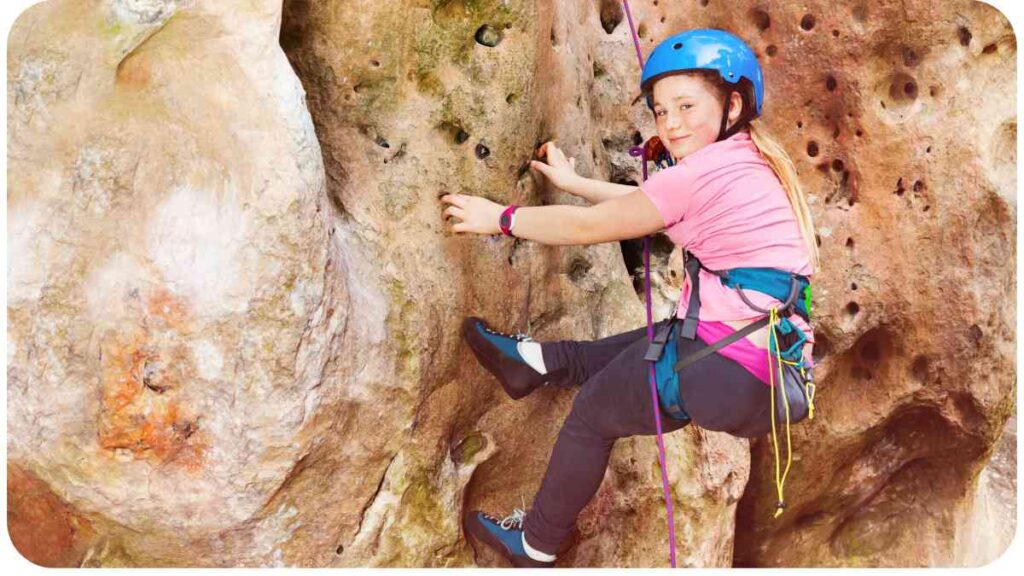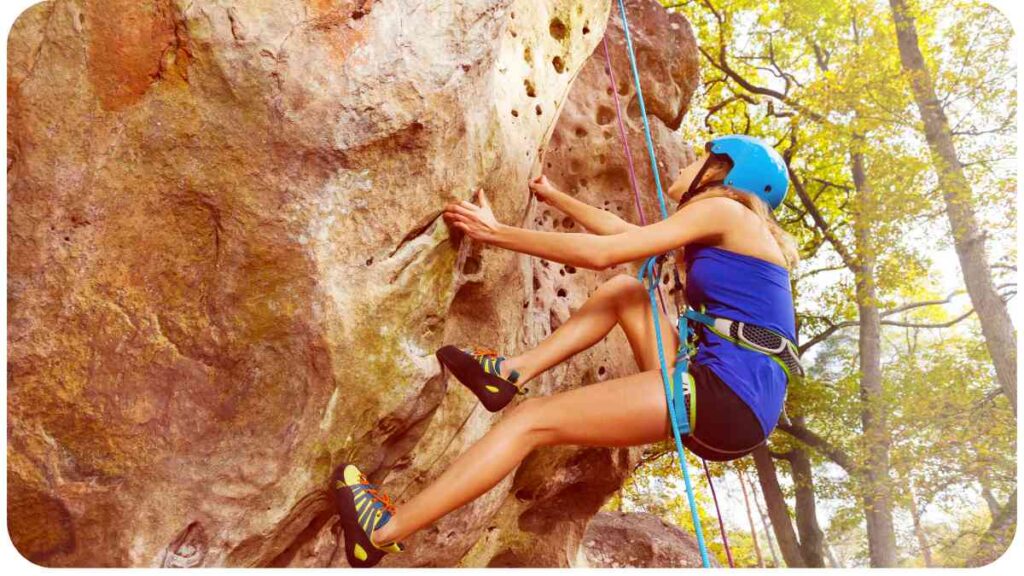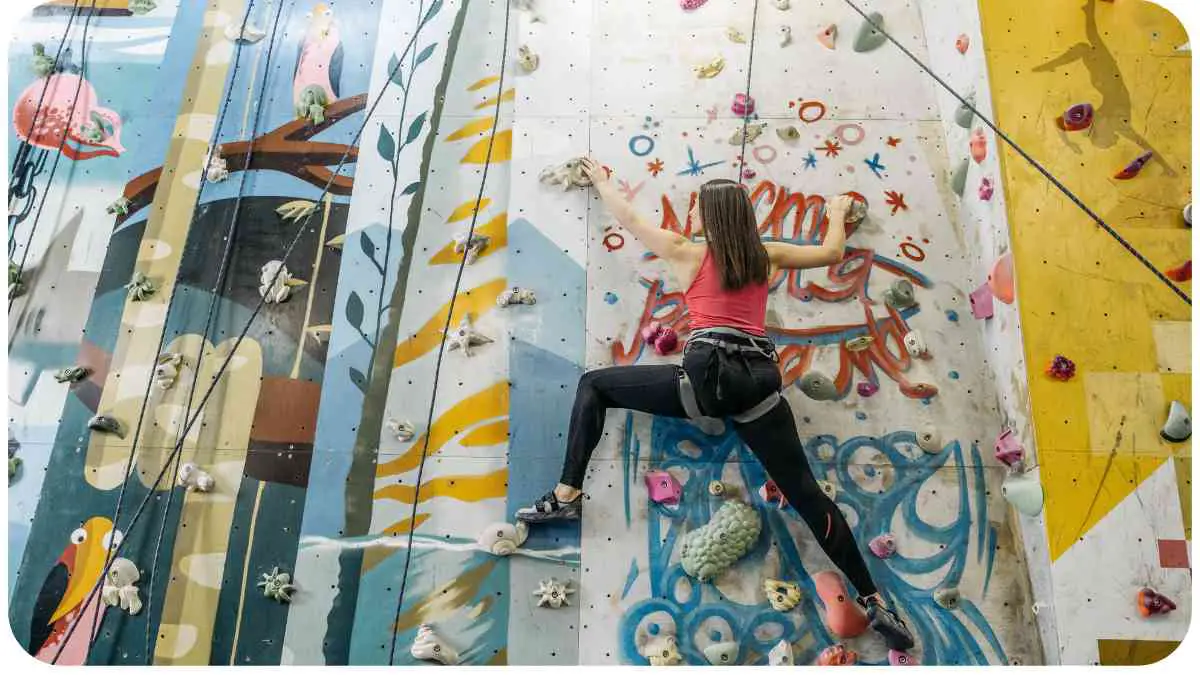Climbing harnesses are essential gear for climbers, providing safety and security while scaling vertical terrains. However, one common issue climbers face is harness twisting, which can be both uncomfortable and affect performance.
In this article, we will explore why climbing harnesses twist, how to identify the problem, and most importantly, how to fix and prevent it. By understanding the root causes and implementing proper techniques, you can ensure a comfortable and secure climbing experience.
| Takeaways | |
|---|---|
| 1 | Proper fitting is crucial to prevent harness twisting. Ensure your harness is snug, with correctly threaded leg loops and waistbelt. |
| 2 | Regularly inspect and maintain your climbing harness to identify any signs of wear, damage, or misalignment. |
| 3 | If your harness twists while wearing it, loosen the leg loops and waistbelt, rotate the components to align properly, and tighten them again. |
| 4 | Crossed leg loops are a common cause of harness twisting. Keep them parallel and avoid any overlapping. |
| 5 | Consider using a harness with a centering loop or middle marker to help maintain proper alignment and prevent twisting. |
| 6 | Retire your harness if it shows signs of wear or has reached its recommended lifespan. Safety should always be the top priority. |
| 7 | Explore additional resources to learn more about putting on a climbing harness correctly and fixing twisting issues. |
| 8 | Consult professionals or experienced climbers for personalized guidance in addressing specific harness twisting concerns. |
2. Understanding Climbing Harness Twists
Anatomy of a Climbing Harness
Before delving into the causes and remedies for harness twisting, let’s first familiarize ourselves with the components of a typical climbing harness. A climbing harness consists of a waistbelt, leg loops, belay loop, and adjustment buckles. These parts work together to distribute forces evenly and ensure stability during climbs.
In the fast-paced world of speed climbing, avoiding common pitfalls is crucial. To enhance your performance, learn from the top mistakes made by climbers and discover effective strategies for success.
How Twisting Occurs

Harness twists occur when the waistbelt and leg loops rotate relative to each other, resulting in an uncomfortable and potentially hazardous situation. Twists can occur due to improper fitting, twisting while putting on the harness, or during climbing movements that cause the gear to shift.
Impact on Safety and Performance
Twisted harnesses can cause discomfort, affecting your climbing experience and potentially impairing your performance. Uncomfortable pressure points and restricted movement can distract and tire climbers, leading to reduced focus and agility. Additionally, a twisted harness may compromise overall safety, as it can interfere with the correct functioning of other safety equipment, such as carabiners and belay devices.
Common Causes of Twisting
Several factors contribute to harness twisting. Improper fitting is a primary cause, where an ill-fitting harness is more likely to rotate and move against your body while climbing. Additionally, incorrect threading of leg loops and waistbelt, as well as the presence of crossed leg loops, can also lead to twisting. Lastly, age, wear and tear, or inadequate maintenance of your harness can increase the likelihood of twisting.
Twisted ropes can hinder your climb. Understand the importance of handling rope twists to ensure a smooth ascent. Uncover practical tips for preventing twists and efficiently unwinding knots during your climbing adventures.
In the next sections, we will explore how to identify harness twists and provide practical solutions to fix and prevent them effectively.
3. Identifying Harness Twists
Visual Inspection
One of the simplest ways to determine whether your climbing harness is twisted is through a visual inspection. Lay your harness flat on the ground and observe if any part appears twisted or rotated in relation to the others. Pay close attention to the waistbelt, leg loops, and buckles. If any misalignment is noticeable, it’s likely that your harness is twisted.
Physical Examination
Besides visually inspecting your harness, it is crucial to physically examine it as well. Run your hands along the waistbelt and leg loops, feeling for any twists or knots in the material. Additionally, check the buckles and attachment points for signs of improper alignment. A thorough physical examination will help you confirm any suspicions of harness twisting.
Conquer the climbing wall with expert advice on bouldering tricks and tips. Elevate your bouldering skills overnight by learning proven techniques and insider tips. Master the art of climbing with confidence and finesse.
Fitting and Adjustment
One common cause of harness twisting is improper fitting. When putting on your harness, ensure that each leg loop and the waistbelt is correctly threaded through the corresponding buckle. Also, take note of the desired tightness and adjust the waistbelt and leg loops accordingly. Any overlapping or crossing of leg loop straps should be avoided, as it can contribute to twisting.
Harness Age and Wear
Over time, climbing harnesses can experience wear and tear, affecting their performance and increasing the likelihood of twists. Pay attention to the age, usage frequency, and any visible signs of deterioration. If your harness is reaching its recommended lifespan or showing noticeable signs of degradation, it’s advisable to retire it and invest in a new one. Regular maintenance and care can also help extend the lifespan of your harness.
Now that we have learned how to identify harness twists, let’s move on to the solutions for correcting and preventing them.
4. Fixing and Preventing Twists
Proper Fitting Techniques
To prevent harness twisting, ensuring a proper fit is crucial. Begin by determining your waist size and selecting a harness with an appropriate range. When putting on the harness, tighten the waist belt snugly around your waist while ensuring it remains comfortable.
Adjust the leg loops to a snug fit as well, ensuring they are not too tight or too loose. A well-fitted harness minimizes the chances of twisting and enhances your overall climbing experience.
Comfort is key in climbing. If you’re wondering, ‘Why is my climbing harness causing discomfort?’ find solutions here. Explore insightful fixes and tips to ensure your climbing harness fits securely, providing both comfort and safety during your climbing escapades.
Adjusting Leg Loops and Waist Belt
If you notice that your harness is twisted while wearing it, you can make some adjustments to correct the issue. Start by loosening the leg loops and waist belt, allowing the harness to relax. Then, carefully rotate the waist belt and leg loops in opposite directions until they align properly. Once aligned, tighten the leg loops and waist belt again to secure the corrected position.
Using a Centering Loop/Middle Marker
Some more advanced harness models come with a centering loop or middle marker. This feature is a useful tool to prevent harness twisting. When adjusting your harness, ensure that this loop or marker is centered on your body. It acts as a reference point, helping to maintain the correct orientation of the harness components and reducing the likelihood of twisting.
Avoiding Crossed Leg Loops
Crossed leg loops are a common cause of harness twisting. To avoid this issue, ensure that the leg loop straps do not cross over each other. Check for proper alignment and adjust the leg loops accordingly to keep them parallel and prevent twisting. This simple adjustment during the fitting process can significantly reduce the chances of a twisted harness.
Maintain a solid grip while bouldering by addressing grip slipping issues. Discover effective techniques to enhance your hold and enjoy a more secure and enjoyable climbing experience. Overcome challenges with practical advice tailored to bouldering enthusiasts of all levels.
Regular Maintenance and Inspection
To maintain the performance and safety of your climbing harness, it’s essential to perform regular maintenance and inspection. Inspect your harness before each climbing session, paying attention to the straps, buckles, and attachment points.
Look for signs of wear, fraying, or damage. If you notice any issues, replace the affected parts or retire the harness if necessary. Regular cleaning and storing your harness properly also contribute to its longevity and functionality.
5. Top Climbing Harness Brands and Models

When choosing a climbing harness, it’s beneficial to consider reputable brands known for their quality and durability. Here is a comparison table of some highly regarded climbing harness brands and models:
| Brand | Model | Features | Price Range |
| Black Diamond | Momentum | Adjustable leg loops, lightweight | 70 |
| Petzl | Sama | Flexible waistbelt, breathable padding | 120 |
| Mammut | Zephir | Minimalist design, high mobility | 100 |
| Edelrid | Jay | Split webbing technology | 90 |
| Arc’teryx | AR-395a | Adaptive Fit technology | 200 |
This table showcases some popular harness models from various brands, highlighting key features and a rough price range. Remember to try on different models and brands before making a purchase to find the most suitable harness for your climbing needs.
6. Conclusion
Climbing harness twisting can be a frustrating and uncomfortable experience that significantly impacts your climbing performance and safety. By understanding the causes and implementing proper fitting techniques, adjustments, and maintenance, you can fix and prevent harness twists effectively.
Remember to choose a climbing harness from a reliable brand that fits your needs and considerations. Regularly inspect and maintain your harness to ensure its longevity and optimal functionality. With these tips and insights, you can enjoy a comfortable and safe climbing experience, unfettered by harness twisting.
Further Reading
Here are some additional resources where you can find more information about climbing harnesses, fixing twisting issues, and related topics:
- REI: How to Put on a Climbing Harness This REI article provides a step-by-step guide on how to correctly put on a climbing harness, ensuring a safe and secure fit.
- Mountain Project Forum: Getting Twists Out of a Climbing Rope This Mountain Project forum thread discusses different techniques and tips for removing twists from climbing ropes, which can help prevent harness twisting.
- TreeClimbing.com Forum: Twisting Rope This thread from the TreeClimbing.com forum explores the topic of twisting rope and provides insights into how to address the issue.
FAQs
Here are some frequently asked questions about climbing harness twists along with their answers:
How can I prevent my climbing harness from twisting?
To prevent your climbing harness from twisting, make sure to properly fit and adjust it according to the manufacturer’s instructions. Avoid crossing your leg loops and regularly inspect and maintain your harness for wear and tear.
What should I do if I notice a twist in my climbing harness?
If you notice a twist in your climbing harness while wearing it, you can try loosening the leg loops and waistbelt, rotating the harness components until they align properly, and then tightening them again. If the twist persists or you have concerns, consult with a professional or replace the harness if necessary.
Can using a centering loop help prevent harness twisting?
Yes, using a centering loop or middle marker can be a helpful feature in preventing harness twisting. Ensure that the centering loop is properly positioned in the middle of your body while adjusting your harness.
How often should I inspect and maintain my climbing harness?
It is recommended to inspect your climbing harness before each climbing session. Look for any signs of wear, damage, or improper alignment. Additionally, regular maintenance, including cleaning and storing the harness properly, helps ensure its longevity and functionality.
Should I retire my climbing harness if it is showing signs of wear?
If your harness is showing visible signs of wear, fraying, or damage, it is advisable to retire it and invest in a new one. Safety should always be a priority, and a compromised harness may not provide the necessary protection during climbs.
Remember, if you have any specific concerns or questions related to your climbing harness or twisting issues, consult with professionals or experienced climbers for personalized guidance and assistance.

Welcome to my blog! I’m Hellen James, and I’m incredibly passionate about rock climbing, bouldering, ice climbing, and mountaineering. Join me as I embark on thrilling adventures, conquer vertical challenges, and share my experiences and insights with fellow outdoor enthusiasts.


